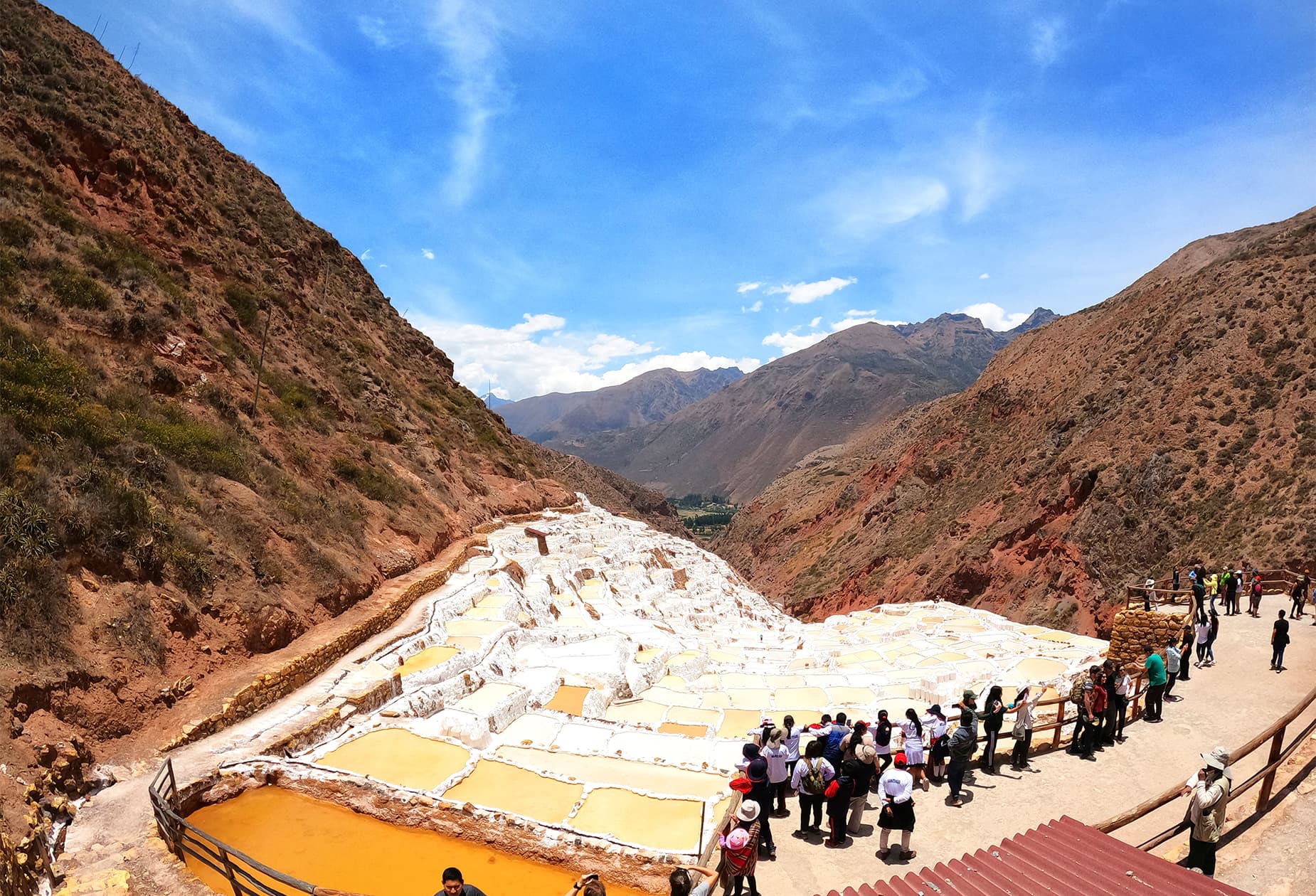-
Contact Numbers +51 961 940 225
-
Contact us hikingtrailsperu@gmail.com
- Enquire Now
Salt Mines Tour
Half Day Tour
-
-
Group Size Up to 8
-
Activity Level Relaxing
-
Trip Type Journeys
-
- Book Now
Peru, a land steeped in rich history and breathtaking landscapes, offers a plethora of experiences that captivate the hearts of travelers. Among its many wonders are the Salineras of Maras, the Moray Inca ruins, and the quaint village of Chincheros. Embarking on a salt mines tour in this region not only promises an educational journey through time but also an exploration of Peru’s natural and cultural heritage.
Itinerary
Cusco - Salt Mines - Maras Moray - Chinchero.
Our tour begins with a scenic drive from your hotel in Cusco. As we travel in private transportation, the unfolding landscape offers a visual feast of snow-capped peaks and lush farmlands, setting the stage for the incredible sights ahead. The journey itself is as much a part of the experience as the destinations, offering glimpses into the everyday life of the Peruvian highlands.
Upon reaching the Salineras of Maras, you’re greeted by a stunning view of over 3,000 evaporation chambers or salt pools, cascading down the valley like a patchwork quilt of earthen tones. These salt mines, dating back to pre-colonial times, are not just historical relics but are still active today. The sight of local workers harvesting salt as their ancestors did adds a touch of authenticity and continuity to the experience.
The process of salt extraction at Maras is both simple and ingenious. Natural spring water, rich in minerals, is channeled into the shallow pools. As the water evaporates under the sun, it leaves behind crystals of pure salt. This method, honed over centuries, is a testament to the resourcefulness of the ancient Peruvians and their intimate understanding of their environment.
Leaving the Salineras, our next stop is the Moray Inca ruins. Here, you’ll witness the remarkable engineering prowess of the Incas. The site consists of several terraced circular depressions, which many believe were used by the Incas as an agricultural laboratory.
Each terrace in Moray creates its own microclimate. The temperature difference between the top and the bottom can be as much as 15 degrees Celsius. This ingenious design allowed the Incas to experiment with crops at different altitudes and temperatures, leading to the development of resilient agricultural practices that are still admired today.
The visit to Moray offers more than just a glimpse into ancient farming techniques; it’s a window into the sophisticated societal structure of the Incas, where agriculture played a central role. The knowledge gained here helped sustain a large empire across diverse and challenging terrains.
The final leg of our journey takes us to Chincheros, a small Andean village that seems to have stood still in time. Known for its traditional weaving and colorful markets, Chincheros offers an authentic taste of Andean culture.
In Chincheros, you’ll witness the intricate art of Andean weaving, passed down through generations. The use of natural dyes and traditional looms results in textiles of extraordinary beauty and complexity, each piece telling a story of the Andean way of life.
A visit to the local market is a sensory experience, with stalls bursting with vibrant colors and the air filled with the aromas of traditional Peruvian cuisine. This is an opportunity to interact with the locals, understand their way of life, and perhaps take home a piece of Andean artistry.
As we make our way back to Cusco, you’ll have time to reflect on the day’s experiences. Each site visited offers a unique perspective on Peru’s rich history and cultural diversity. From the ancient salt mines of Maras to the agricultural wonders of Moray, and the vibrant life in Chincheros, this tour is more than just a sightseeing trip; it’s a deep dive into the heart of Peruvian heritage.
Inclusions
Whats Included?
- Hotel Pick-up: Your journey begins with a comfortable pick-up from your hotel in Cusco, ensuring a hassle-free start to your adventure.
- Private Tourist Van: Travel in style and comfort from Cusco to the trailhead in a private tourist van, enjoying the picturesque landscapes along the way.
- Expert Guidance: Our knowledgeable, English-speaking tour guide accompanies you throughout the journey, providing fascinating insights into the history, culture, and significance of the Rainbow Mountain.
- First aid kits: We prioritize your safety with a comprehensive first aid kit, an oxygen tank, and trekking poles to ensure a secure and enjoyable trek.
- Return to Cusco: relax in the comfort of our private tourist van for the return journey from the trailhead to Cusco.
- Drop-off at Your Hotel: We conclude our tour by dropping you off at your hotel, ensuring a seamless and convenient end to your memorable adventure.
Not Included
- Meals
- Tourist Ticket : 70 Soles (if you would like to do the Sacred Valley Tour will be better to buy the full tourist ticket – 130 peruvian Soles )
Price
-
Private Service
$ 150 per person
-
Luxury Service
$ 700 per person
-
Regular Service
$ 120 per person
-
2 People
$ 115 per person
-
3 People
$ 110 per person
-
4 People
$ 105 per person
-
5 People
$ 100 per person
-
6 People
$ 95 per person
-
7 People
$ 90 per person
-
8 People
$ 85 per person
Packing List
Packing checklist
- Original Passport: This is your primary travel document. Keep it secure and accessible throughout your journey.
- Comfortable Shoes, Sneakers, or Tennis Shoes: Your feet are your best friends on any trip. Choose footwear that provides comfort and support for various activities.
- Rain Gear and Rain Ponchos: Don’t let unexpected showers dampen your spirits. Lightweight and compact rain gear is a must-have.
- Long-Sleeved T-Shirt: Perfect for layering, these are essential for protection against the sun or cooler evenings.
- Comfortable Clothes: Think of clothes that are versatile, breathable, and easy to move in. They should suit the climate and activities of your destination.
- Sunscreen (High SPF): Protect your skin from the sun’s harmful rays, regardless of the weather.
- Sun Hat: Choose a hat that offers ample sun protection.
- Sunglasses: Protect your eyes and add some style to your outfit.
- Any Personal Medication: Essential for maintaining your health and well-being while traveling.
- Small Day Pack: Ideal for carrying your daily essentials. Make sure it’s comfortable to carry for long periods.
- Camera and Extra Batteries: To capture those unforgettable moments. The extra batteries ensure you’re always ready to snap away.
- Extra Money (Small Denominations of Peruvian Coins or American Dollars): Useful for small purchases and places where cards may not be accepted.
- Snacks: Keep your energy levels high with some nutritious, easy-to-carry snacks.
Faqs
Absolutely! Moray, a gem within the Maras Moray & Salt Mines tour, is a must-see destination. Famous for its intriguing circular terraces, Moray is believed to have been an Inca agricultural laboratory. Each level’s unique microclimate showcases the Incas’ ingenuity in crop experimentation. Besides its historical significance, Moray captivates with stunning panoramic views, making it a photographer’s paradise. This site offers a unique glimpse into Incan civilization and their advanced agricultural practices. So, for history enthusiasts and nature lovers alike, a visit to Moray is not just worth it, it’s essential.
To visit Moray, part of the enchanting Maras Moray & Salt Mines tour, you have several options. Firstly, consider joining a guided tour, which often includes transportation, insightful commentary, and sometimes a visit to the nearby Maras Salt Mines. Alternatively, if you prefer independent travel, you can rent a car or take public transportation from Cusco to Moray. Upon arrival, pay the entrance fee, which is often included in the Boleto Turistico, a ticket that grants access to multiple sites in the region. Remember to wear comfortable walking shoes and bring water, as exploring the terraces involves some walking.
In English, “Salineras de Maras” is referred to as the Maras Salt Mines. These striking salt pans, nestled in the heart of the Sacred Valley, are a testament to the ingenuity of the Incas. Local families have harvested the salt here for centuries, using a traditional method where spring water, rich in minerals, is directed into the pans and evaporates, leaving behind the crystalline salt. This site not only offers a glimpse into an ancient practice but also provides a breathtaking landscape, making it a must-visit destination on the Maras Moray & Salt Mines tour.
Maras, a town in the Sacred Valley, is renowned for its extraordinary Salineras de Maras or salt mines. What makes Maras special is its centuries-old salt pans, which are fed by natural springs. These salt pans, arrayed like a patchwork quilt on the hillside, not only have historical significance dating back to Inca times but also provide a stunning, photogenic landscape. Visiting Maras offers an insightful glimpse into traditional salt harvesting techniques that continue to be practiced today. This unique blend of history, culture, and natural beauty makes Maras a standout destination in the Maras Moray & Salt Mines experience.
We recommend comfortable walking shoes, sunscreen, sunglasses, a hat, and a camera. The weather can be variable, so a light jacket or sweater is advisable.
Yes, our tour is designed to be enjoyable for all ages. However, please note that there is some walking involved, especially at the Moray terraces.
Absolutely! Purchasing salt from the Salineras is a great way to support the local community and take home a unique souvenir from your trip.
Maras, a town with deep historical roots, is celebrated for its iconic Salineras de Maras or Maras Salt Mines. These mines, predating the Inca Empire, have been a cornerstone of local economy for centuries. Initially used by pre-Incan civilizations, the mines gained prominence under Incan stewardship. The intricate network of salt pans, ingeniously carved into the hillside, harnesses spring-fed saline waters. This sustainable technique has been passed down through generations. Today, Maras stands as a testament to enduring Andean traditions, blending history and culture in the mesmerizing landscape of the Maras Moray & Salt Mines.
Nestled in the Sacred Valley, Maras is renowned for its Salineras de Maras, a breathtaking sight of ancient salt pans. These terraced pools, dating back to pre-Inca times, are fed by natural springs, creating a stunning mosaic of crystalline patches. What makes Maras truly special is its enduring tradition; locals have harvested salt here for centuries using methods passed down through generations. This blend of historical significance and natural beauty sets Maras apart, making it a must-visit destination in the Maras Moray & Salt Mines region. Visitors are captivated by both the scenic landscape and the rich cultural heritage it represents.
In the heart of the Sacred Valley, ‘Maras’ holds a special place. This name, rooted in local history, is synonymous with the iconic Salineras de Maras – the ancient salt mines that have been a cornerstone of the region’s economy and culture. These salt pans, a marvel of Incan engineering, are more than just a picturesque landscape; they represent a living legacy of traditional salt harvesting techniques. The word ‘Maras’ is not just a name; it embodies the enduring spirit of an age-old community practice, linking the past with the present in a harmonious blend of culture and nature.
In the context of Maras, especially around the Maras Moray & Salt Mines, it’s important to clarify that ‘Maras’ refers to a location, not a species or group with a specific diet. The region, known for its stunning landscapes and rich history, does not have a unique dietary habit. Instead, the local cuisine reflects traditional Peruvian flavors, with an emphasis on corn, potatoes, quinoa, and other native Andean crops. Visitors can savor a variety of regional dishes, each offering a taste of the rich cultural and agricultural heritage of Maras and the Sacred Valley.
Similar tours that you may like
We are accredited by
















